How to Maintain the Sustainable Development of a Business Platform: A Case Study of Pinduoduo Social Commerce Platform in China
Abstract
1. Introduction
2. Literature Review
2.1. eCommerce Platform Business Module
2.2. Multiple Roles of a Platform Provider
2.2.1. Early Spread Stage: Incentives to Users
2.2.2. Late Evolution Stage: Quality Control and Revenue Structure
2.3. Business Ecosystem
3. Research Design and Methodology
3.1. Conceptual Framework
3.2. Research Methodology
3.2.1. Case Study
3.2.2. Rationale for Case Selection
3.2.3. Data Collection Method
3.2.4. Data Analysis Method
4. Findings
4.1. Findings from Secondary Data Collection: Pinduoduo in Business Ecosystem
- The early stage (2015.9–2018.7) is the spread stage of the platform. Relying on the feature of “social + eCommerce”, Pinduoduo platform not only successfully attracted more than 1 billion active users of Wechat, but also caught the market of long tail. Since Wechat only opens its traffic pool to the Pinduoduo platform, it avoids the problem which was mentioned by Kim. The question he mentioned was, as more social commerce firms have joined the industry, fierce competition has ensued [22]. The biggest contradiction in this stage is online supply chain control and merchant supervision. The negative comments received are mainly concentrated towards the problem, such as the goods have not been received, a poor product quality, existing fake and inferior commodities in the platform and so on.
- The later stage (2018.8–present) is the evolution stage of the platform. Pinduoduo was listed on Nasdaq on 26 July 2018. However, in August 2018, Pinduoduo was held accountable by the Shanghai government and was asked to solve problems proposed by the users in spread stage. Since then, Pinduoduo has paid more attention to the quality management and revenue structure. In the stage of expansion, by providing differentiated services to users and adding platform components, Pinduoduo has been transformed from a social commerce platform to an inclusive business ecosystem (as shown in Figure 9 below).
4.2. Findings from Primary Data Collection
4.2.1. Spread Stage: Incentives for Participants
“Low Price + Social Contact” Strategy
- Group Buying: Compared with competitors, the group buying mode employed by Pinduoduo provides lower price products for customers. Every kind of good on Pinduoduo platforms can be purchased through the mode of “buying direct” and the mode of “group buying”. Yet if the consumer chooses the mode of group buying, they are able to buy the product at a price lower than the market price. The people at the bottom of the pyramid are extremely price sensitive [69]. Thus they naturally choose the mode of “group buying”. Often, the active users who want to buy goods at the lowest price will become a leader, and attract passive users to participate in group buying, as shown in Figure 10 (Source:ThoughtWorks company). Meanwhile, Pinduoduo platform summarizes the customer demands and feedback to the supply-side, which can reduce any intermediate links and obtain the price advantage.
- Rapid Information Transmission through Social Media: Information transmission through social media not only helps the platform reduce the average customer cost and then reduce the price of the product, but also provides an easy-operating function for the people at the bottom of the pyramid. This is because the consumers only need to open the website link of the commodity purchase sent by their acquaintances in WeChat and they can directly purchase this commodity. It does not require a tedious search and operation process which are in line with the characteristics of the people at the bottom of the pyramid who are less educated and unfamiliar with the Internet. Social networks consist of large numbers of individuals who are potential content generators and a massive source of information [49]. According to people’s role in information transmission on Pinduoduo platform, they can be divided into four categories: (1) super-star, (2) key opinion leader (referred to as KOL), (3) a location-based relationship related parties (referred to as LBS related parties) (Such as fellow villagers/neighbors), (4) friend of a friend (referred to as FOAF), as shown in Figure 11 below. The importance of the relationship has been highlighted as a major marketing ingredient of success for any business enterprise [70,71]. In a sense, the role of social media enabling customers to talk to one another is an extension of traditional word-of-mouth communication [72]. It is particularly worth mentioning here that compared with those on larger incomes, people at the bottom of the pyramid tend to create a stronger sense of community and social network, based on mutual help [73]. On the basis of the above theory, Pinduoduo platform encourages consumers to take the initiative in attracting potential users. In order to reach the minimum number of people who are required for group-buying and then make themself enjoy lower prices, people at the bottom of the pyramid usually share advertisements of group-buying through social media, such as WeChat. Meanwhile, people tend to have stronger ties with those more like themselves [74]. Therefore, the shared commodity information can quickly flow to the target groups with corresponding consumer preferences, and find the potential consumers.
“Gamification + Brand Channel” Strategy
4.2.2. Evolution Stage: Quality Management
- Front-end quality control - the platform achieves transparent production through the “visual platform” in the form of a live broadcast. Consumers can see the whole process of product manufacturing. In the process of a live broadcast, consumers can comment at any time, and those who have bought can also share their user experience, providing a beneficial interactive environment for consumers;
- Middle-end quality control - all production information of the factory is synchronised to the platform for record, and the full line of the commodity will be traced to realise ‘quality upgrade’. The platform promises that the products will be inspected by any third party. If consumers find problems with the products, the platform will refund the merchants ten times of the historical total sales amount of the products involved, and compensate all the fines to the consumers;
- Back-end quality control - based on analysis of a large amount of data obtained from BOP groups, the platform helps small micro enterprises keep the key products performance and exclude high-end functions to better meet the demand of BOP users to realise ‘demand to upgrade’.
4.2.3. Evolution Stage: Revenue Structure and Value Chain
5. Discussion
5.1. Central Question: How Do the Dynamic Roles of Platform Providers Change over Time?
5.2. Sub-Question 1: How Do Incentives to Participants on the Social Commerce Platform in Spread Stage?
5.3. Sub-Question 2: How Is It Best to Conduct Quality Control on the Social Commerce Platform?
5.4. Sub-Question 3: How Is It Best to Apply a Suitable Revenue Structure on the Social Commerce Platform?
6. Conclusions and Future Research
- Human-oriented platform design to stimulate potential demands. Traditional eCommerce platforms usually pay more attention to “goods” and “shopping malls” without consideration of the real needs of platform participant. Besides improving productivity and expanding sale channels, a ‘human-oriented’ design concept also encourages deep insight into the user’s demands and even emotional experiences behind demands via digital technologies and social medias;
- Inclusive platform design to build business ecosystem. Diversification of Chinese society has resulted in the structural stratification of consumption. Different operating strategies should be adopted for different consumer groups. In general, consumers with high-level consumption pay more attention to consumption experience, and are willing to pay for brand premium and emotional value of products. BOP group, on the other hand, are still in the stage of price sensitivity, whose demands are often ignored by mainstream enterprises and platforms.
Author Contributions
Funding
Conflicts of Interest
Appendix A
| Introduction | -Job description and function in the platform |
| Platform Background | -Initiatives and value proposition in Pinduoduo platform? -Technological capabilities of the platform providers? |
| Incentives to Participants | -Comment on the user growth pattern in Pinduoduo platform? -Comment on motivations for supply-side users? -Comment on motivations for demand-side users? |
| Quality Management | -Comment on balance between content quality and aggressive user growth -Explanations on the regulation architecture in Pinduoduo platform -Comments on the changes in quality regulation -Comparison among other platforms |
| Revenue Structure | -Explanations on revenue stream from demand-side users -Explanations on revenue stream from supply-side users -Explanations on revenue stream from cooperative users -Comments on revenue structure in Pinduoduo platform |
| Question Number | Concrete Content |
|---|---|
| Question 1: | -How did you find the platform of Pinduoduo? -Have you used other eCommerce platforms before? -Why did you switch from other platforms to Pinduoduo platform? |
| Question 2: | -What motivates you to sell products on Pinduoduo platforms? -What do you find most attractive about the platform? |
| Question 3: | -How do you join in Pinduoduo platform and do you need to pay for it? |
| Question 4: | -How do you accumulate customers? -What is the way you earn more from Pinduoduo platform? |
| Question 5: | -Please provide a general comment on your usage experience in Pinduoduo platform? |
| Question Number | Concrete Content |
|---|---|
| Question 1: | -How did you find the platform of Pinduoduo? -Have you used other eCommerce platforms before? -Why did you switch from other platforms to Pinduoduo platform? |
| Question 2: | -What motivates you to buy goods on Pinduoduo platforms? -In other words, how do you find this platform most attractive to you? |
| Question 3: | -How do you choose the products on the platform of Pinduoduo? -Which aspect do you pay more attention to when choosing goods? |
| Question 4: | -Are you satisfied with the quality of goods on the platform of Pinduoduo? |
| Question 5: | -Please provide a general comment on your usage experience in Pinduoduo platform? |
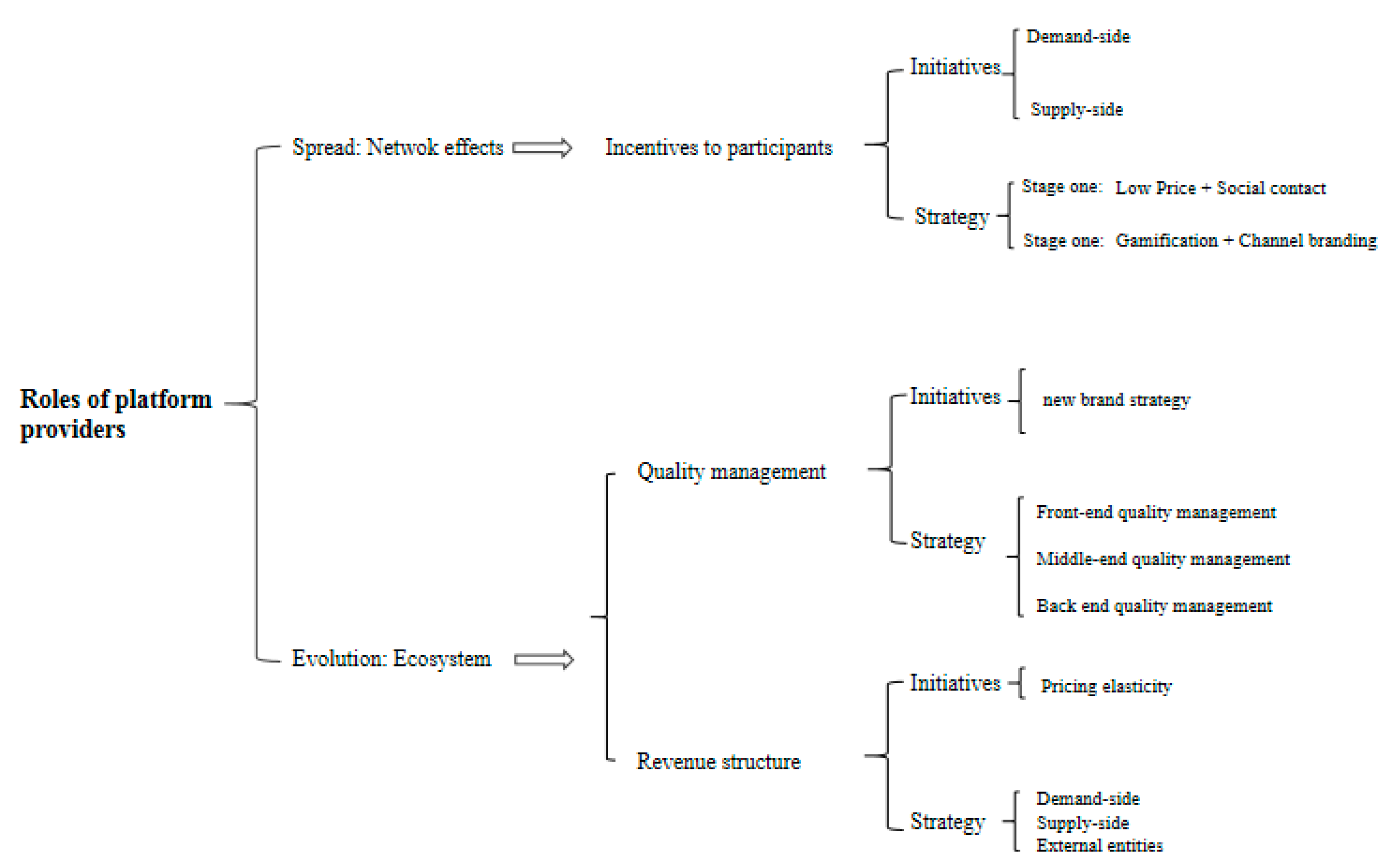
| Theme | Sub-Category | Sample of Coded Text |
|---|---|---|
| Incentives to participants | Low cost products + Social network |
|
| Gamification + Channel brand |
| |
| Quality management | Front-end quality management |
|
| Middle-end quality management | ||
| Back-end quality management | ||
| Revenue structure | Pricing elasticity |
|
References
- Sami, A.; Hashim, K.F.; Yusof, S.A.M. Continuous use of social commerce: Its conceptual relation with E-WOM, commitment and trust. Int. Conf. Appl. Sci. Technol. 2016, 1761, 20095. [Google Scholar]
- Kirilka, V.; Stukas, T. Strategic Renewal in Retail Companies by Means of Social e-Commerce. 2012. Available online: http://hj.diva-portal.org/smash/get/diva2:528850/FULLTEXT01.pdf (accessed on 3 November 2019).
- Kim, Y.; Srivastava, J. Impact of social influence in e-commerce decision making. In Proceedings of the Ninth International Conference on Electronic Commerce, Minneapolis, MN, USA, 19–22 August 2007; ACM: New York, NY, USA, 2007; pp. 293–302. [Google Scholar]
- China Internet Association. Report on the Development of China’s Social E-Commerce Industry in 2018. Available online: http://baogao.chinabaogao.com/hulianwang/355655355655.html (accessed on 6 August 2018).
- UBS Evidence Lab. Pinduoduo Development Report. Available online: https://www.guancha.cn/ChanJing/2019_03_12_493245.shtml (accessed on 12 March 2019).
- Kim, J. The Platform Business Model and Strategy: A Dynamic Analysis of the Value Chain and Platform Business. Ph.D. Thesis, The University of Manchester, Manchester, UK, 2016. [Google Scholar]
- Armstrong, M. Competition in two-sided markets. RAND J. Econ. 2006, 37, 668–691. [Google Scholar] [CrossRef]
- Rochet, J.C.; Tirole, J. Two-sided markets: A progress report. RAND J. Econ. 2006, 37, 645–667. [Google Scholar] [CrossRef]
- Evans, D.S.; Hagiu, A.; Schmalensee, R. Invisible Engines: How Software Platforms Drive Innovation and Transform Industries; MIT Press: Cambridge, MA, USA, 2008. [Google Scholar]
- Zhang, X.; Zhao, J. Platform strategy and innovation under the background of new industrial revolution: A case study of haier’s platform strategy. Sci. Sci. Manag. S.& T. 2015, 3, 77–86. (In Chinese) [Google Scholar]
- Malone, T.W.; Yates, J.; Benjamin, R.I. Electronic Markets and Electronic Hierarchies; Oxford University Press: Oxford, UK, 1987. [Google Scholar]
- Bakos, Y. The emerging role of electronic marketplaces on the internet. Commun. ACM 1998, 41, 35–42. [Google Scholar] [CrossRef]
- Willis, J.L. What impact will e-commerce have on the US economy? Econ. Rev. 2004, 89, 53–73. [Google Scholar]
- Barkley, D.L.; Lamie, R.D.; Markley, D.M. Case Studies of E-Commerce in Small and Medium-sized Enterprises: A Review of the Literature; University Center for Economic Development Working Paper; Clemson University: Clemson, SC, USA, 2007; Volume 10, p. 16. [Google Scholar]
- Rikkiev, A.; Mäkinen, S.J. Technology convergence and intercompany R&D collaboration: Across business ecosystems boundaries. Int. J. Innov. Technol. Manag. 2013, 10, 1350009. [Google Scholar]
- Cai, N.; Wang, J.; Yang, D. Platform envelopment strategy decision and competitive advantage building under the background of industrial convergence—A case study of ZDM. China Ind. Econ. 2015, 5, 96–109. (In Chinese) [Google Scholar]
- Kim, J. The platform business model and business ecosystem: Quality management and revenue structures. Eur. Plan. Stud. 2016, 24, 1–20. [Google Scholar] [CrossRef]
- Han, J.; Cho, O. Platform business eco-model evolution: Case study on kakaotalk in Korea. J. Open Innov. Technol. Mark. Complex. 2015, 1, 6–14. [Google Scholar] [CrossRef]
- Evans, D.S. How Catalysts Ignite: The Economics of Platform-Based Start-Ups. In Platform, Markets and Innovation; Edward Elgar Publishing: Cheltenham, UK, 2009; pp. 99–128. [Google Scholar]
- Jascanu, N.; Jascanu, V.; Nicolau, F. A New Approach to E-Commerce Multi-Agent Systems; Dunarea de Jos University of Galati: Galati, Romania, 2007; Available online: http://www.arthra.ugal.ro/handle/123456789/3882 (accessed on 3 November 2019).
- Dennison, G.; Bourdage-Braun, S.; Chetuparambil, M. Social Commerce Defined; White Paper 23747; IBM Systems Technology Group: Research Triangle Park, NC, USA, 2009. [Google Scholar]
- Kim, D. Under what conditions will social commerce business models survive? Electron. Commer. Res. Appl. 2013, 12, 69–77. [Google Scholar] [CrossRef]
- Culnan, M.J.; McHugh, P.J.; Zubillaga, J.I. How large US companies can use Twitter and other social media to gain business value. MIS Q. Exec. 2010, 9, 124–259. [Google Scholar]
- Ickler, H.; Schülke, S.; Wilfling, S.; Baumöl, U. New challenges in e-commerce: How social commerce influences the customer process. 2009. Available online: http://citeseerx.ist.psu.edu/viewdoc/download?doi=10.1.1.460.5449&rep=rep1&type=pdf (accessed on 3 November 2019).
- Marsden, P. How Social Commerce Works: The Social Psychology of Social Shopping. 2009. Available online: http://www.slideshare.net/paulsmarsden/social-psychology-of-social-shopping-how-social-commerce-works (accessed on 3 November 2019).
- Liang, T.P.; Turban, E. Introduction to the special issue social commerce: A research framework for social commerce. Int. J. Electron. Commer. 2011, 16, 5–14. [Google Scholar] [CrossRef]
- Zheng, X.; Cheung, C.M.K.; Lee, M.K.O.; Liang, L. Building brand loyalty through user engagement in online brand communities in social networking sites. Inf. Technol. People 2015, 28, 90–106. [Google Scholar] [CrossRef]
- Boudreau, K.J.; Hagiu, A. Platform rules: Multi-sided platforms as regulators. Platf. Mark. Innov. 2009, 1, 163–191. [Google Scholar]
- Gawer, A.; Cusumano, M.A. Platform Leaders. In MIT Sloan Management Review; MIT Sloan School of Management: Boston, MA, USA, 2008; pp. 68–75. [Google Scholar]
- Boudreau, K.J.; Jeppesen, L.B. Unpaid crowd complementors: The platform network effect mirage. Strateg. Manag. J. 2015, 36, 1761–1777. [Google Scholar] [CrossRef]
- Rysman, M. Competition between Networks: A Study of the Market for Yellow Pages; Boston University: Boston, MA, USA, 2000. [Google Scholar]
- Lee, S.M.; Kim, T.; Noh, Y.; Lee, B. Success factors of platform leadership in web 2.0 service business. Serv. Bus. 2010, 4, 89–103. [Google Scholar] [CrossRef]
- Tomsen, M.L.; Wu, K.L.; Foreword By-Mathison, D. Killer Content: Strategies for Web Content and E-Commerce; Addison-Wesley Longman Publishing Co., Inc.: Boston, MA, USA, 2000. [Google Scholar]
- Curty, R.G.; Zhang, P. Social commerce: Looking back and forward. Proc. Am. Soc. Inf. Sci. Technol. 2011, 48, 1–10. [Google Scholar] [CrossRef]
- Zhu, F.; Iansiti, M. Dynamics of Platform Competition: Exploring the Role of Installed Base, Platform Quality and Consumer Expectations; Division of Research; Harvard Business School: Boston, MA, USA, 2007. [Google Scholar]
- Ba, S.; Whinston, A.; Zhang, H. Building trust in the electronic market through an economic incentive mechanism. In Proceedings of the 20th international conference on Information Systems (ICIS 1999), Charlotte, NC, USA, 12–15 December 1999. [Google Scholar]
- Ward, M.R.; Lee, M.J. Internet shopping, consumer search and product branding. J. Prod. Brand Manag. 2000, 9, 6–20. [Google Scholar] [CrossRef]
- Akerlof, G.A. The market for lemons: Quality and the market mechanism. Q. J. Econ. 1970, 84, 488–500. [Google Scholar] [CrossRef]
- Hagiu, A. Multi-sided platforms: From microfoundations to design and expansion strategies. In Harvard Business School Strategy Unit Working Paper; Harvard Business School Strategy Unit: Boston, MA, USA, 2009; pp. 9–115. [Google Scholar]
- Rochet, J.C.; Tirole, J. Platform competition in two-sided markets. J. Eur. Econ. Assoc. 2003, 1, 990–1029. [Google Scholar] [CrossRef]
- Rochet, J.C.; Tirole, J. Two-sided markets: An overview. In Institut d’Economie Industrielle Working Paper; MIT Press: Cambridge, MA, USA, 2004. [Google Scholar]
- Caillaud, B.; Jullien, B. Chicken and Egg: Competition among Intermediation Service Providers [EB/OL]; IDEI Working Paper; WILEY-BLACKWELL: Hoboken, NJ, USA, 2002. [Google Scholar]
- Eisenmann, T.; Parker, G.; Van Alstyne, M.W. Strategies for two-sided markets. Harv. Bus. Rev. 2006, 84, 92. [Google Scholar]
- Dubosson-Torbay, M.; Osterwalder, A.; Pigneur, Y. E-business model design, classification, and measurements. Thunderbird Int. Bus. Rev. 2002, 44, 5–23. [Google Scholar] [CrossRef]
- Casadesus-Masanell, R.; Zhu, F. Business model innovation and competitive imitation: The case of sponsor-based business models. Strateg. Manag. J. 2013, 34, 464–482. [Google Scholar] [CrossRef]
- Mahadevan, B. Business models for Internet-based e-commerce: An anatomy. Calif. Manag. Rev. 2000, 42, 55–69. [Google Scholar] [CrossRef]
- Langley, P.; Leyshon, A. Platform capitalism: The intermediation and capitalisation of digital economic circulation. Financ. Soc. 2017, 3, 11–31. [Google Scholar] [CrossRef]
- Klein, B.; Leffler, K. The role of price in guaranteeing quality. J. Political Econ. 1981, 89, 615–641. [Google Scholar] [CrossRef]
- Rad, A.A.; Benyoucef, M. A model for understanding social commerce. J. Inf. Syst. Appl. Res. 2011, 4, 63–73. [Google Scholar]
- Moore, J. The rise of a new corporate form. Wash. Q. 1998, 21, 167–181. [Google Scholar] [CrossRef]
- Roundy, P.; Bradshaw, M.; Brockman, B. The emergence of entrepreneurial ecosystems: A complex adaptive systems approach. J. Bus. Res. 2018, 86, 1–10. [Google Scholar] [CrossRef]
- Garnsey, E.; Leong, Y.Y. Combining Resource-Based and Evolutionary Theory to Explain the Genesis of Bio-networks. Ind. Innov. 2008, 15, 669–686. [Google Scholar] [CrossRef]
- Sheriff, M.; Muffatto, M. The present state of entrepreneurship ecosystems in selected countries in Africa. Afr. J. Econ. Manag. Stud. 2015, 6, 17–54. [Google Scholar] [CrossRef]
- Motoyama, Y.; Knowlton, K. Examining the connections within the startup ecosystem: A case study of St. Louis. Entrep. Res. J. 2017, 7, 1–32. [Google Scholar] [CrossRef]
- Mitchell, J.; Treviranus, J. Inclusive Design in Ecosystems. In E-Health Two-Sided Markets: Implementation and Business Models; Elsevier: Amsterdam, The Netherlands, 2017; pp. 43–61. [Google Scholar]
- Gupta, A.; Dey, A.; Singh, G. Connecting corporations and communities: Towards a theory of social inclusive open innovation. J. Open Innov. Technol. Mark. Complex. 2017, 3, 17. [Google Scholar] [CrossRef]
- Siddiqi, A.; Collins, R.D. Sociotechnical systems and sustainability: Current and future perspectives for inclusive development. Curr. Opin. Environ. Sustain. 2017, 24, 7–13. [Google Scholar] [CrossRef]
- Altman, E.J.; Tripsas, M. Product to platform transitions: Organizational identity implications. In The Oxford Handbook of Creativity, Innovation, and Entrepreneurship; Oxford University Press: Oxford, UK, 2015; pp. 379–394. [Google Scholar]
- Hagiu, A.; Wright, J. Multi-sided platforms. Int. J. Ind. Organ. 2015, 43, 162–174. [Google Scholar] [CrossRef]
- Hyde, K.F. Recognising deductive processes in qualitative research. Qual. Mark. Res. Int. J. 2000, 3, 82–90. [Google Scholar] [CrossRef]
- Ezzy, D. Qualitative Analysis; Routledge: London, UK, 2013. [Google Scholar]
- Yin, R.K. Case Study: Design and Methods; Sage Publications: Newbury Park, CA, USA, 1994. [Google Scholar]
- Miller, D.C. Guides to Methods and Techniques of Collecting Data in Library, Field and Laboratory. In Handbook of Research Design and Social Measurement; SAGE Publications: Newbury Park, CA, USA, 2002; pp. 159–168. [Google Scholar]
- Evergrande Research Institute. New Economy Series Research: Pinduoduo, a Representative of the New Generation of E-Commerce Model, Rise Against the Trend and Shake the Industry Pattern. Available online: https://www.useit.com.cn/thread-22351-1-1.html (accessed on 26 July 2018).
- Denzin, N.K. Interpretive Biography: Qualitative Research Methods Series 17; Sage: Thousand Oaks, CA, USA; London, UK, 1989; Volume 23. [Google Scholar]
- Trochim, W.M. An introduction to concept mapping. Eval. Program Plan. 1989, 12, 1–16. [Google Scholar] [CrossRef]
- Pinduoduo. The Listed Prospectus of “Pinduoduo” in 2018. Available online: https://www.useit.com.cn/thread-19905-1-1.html (accessed on 31 July 2018).
- Prahalad, C.K.; Prahalad, C.K. Strategies for the bottom of the economic pyramid: India as a source of innovation. Reflect. Sol J. 2002, 3, 6–17. [Google Scholar] [CrossRef]
- Karnani, A. Misfortune at the Bottom of the Pyramid. Greener Manag. Int. 2006, 51, 99–110. [Google Scholar] [CrossRef]
- Morgan, R.M.; Hunt, S.D. The commitment-trust theory of relationship marketing. J. Mark. 1994, 58, 20–38. [Google Scholar] [CrossRef]
- Day, G.S. Managing market relationships. J. Acad. Mark. Sci. 2000, 28, 24–30. [Google Scholar] [CrossRef]
- Mangold, W.G.; Faulds, D.J. Social media: The new hybrid element of the promotion mix. Bus. Horiz. 2009, 52, 357–365. [Google Scholar] [CrossRef]
- Barki, E.; Parente, J. Consumer Behaviour of the Base of the Pyramid Market in Brazil. Greener Manag. Int. 2006, 2006, 11–23. [Google Scholar] [CrossRef]
- Haythornthwaite, C. Social networks and online community. In The Oxford Handbook of Internet Psychology; Oxford University Press: Oxford, UK, 2007; pp. 121–137. [Google Scholar]
- Huotari, K.; Hamari, J. Defining gamification: A service marketing perspective. In Proceeding of the 16th International Academic MindTrek Conference, Tampere, Finland, 3–5 October 2012; ACM: New York, NY, USA, 2012; pp. 17–22. [Google Scholar]
- Hofacker, C.F.; De Ruyter, K.; Lurie, N.H.; Manchanda, P.; Donaldson, J. Gamification and mobile marketing effectiveness. J. Interact. Mark. 2016, 34, 25–36. [Google Scholar] [CrossRef]
- Klein, S.; Loebbecke, C. The transformation of pricing models on the web: Examples from the airline industry. In Proceedings of the 13th International Bled Electronic Commerce Conference, Bled, Slovenia, 19–21 June 2000. [Google Scholar]
- Kihlstrom, R.E.; Riordan, M.H. Advertising as a Signal. J. Political Econ. 1984, 92, 427–450. [Google Scholar] [CrossRef]
- Milgrom, P.; Roberts, J. Price and advertising signals of product quality. J. Political Econ. 1986, 94, 796–821. [Google Scholar] [CrossRef]
- Chu, W.; Chu, W. Signaling quality by selling through a reputable retailer: An example of renting the reputation of another agent. Mark. Sci. 1994, 13, 177–189. [Google Scholar] [CrossRef]
- Banerjee, A.V.; Duflo, E. The economic lives of the poor. J. Econ. Perspect. 2007, 21, 141–168. [Google Scholar] [CrossRef] [PubMed]
- Wu, X.; Li, L. Recognition the declining manufacturing industries and growing manufacturing industries in china. Stud. Sci. Sci. 2010, 10, 1476–1483. [Google Scholar]
- Hammond, A.L.; Kramer, W.J.; Katz, R.S.; Tran, J.T.; Walker, C. The Next Four Billion: Market Size and Business Strategy at the Base of the Pyramid; World Resources Institute: Washington, DC, USA, 2007. [Google Scholar]
- Zhang, C.; Wu, X. Micro mechanism and opportunity source and of inclusive growth: Entrepreneurship and bottom of the pyramid (bop). Sci. Technol. Prog. Policy 2013, 9, 1–4. [Google Scholar]
- Adner, R.; Zemsky, P. A demand-based perspective on sustainable competitive advantage. Strateg. Manag. J. 2006, 27, 215–239. [Google Scholar] [CrossRef]
- Citic Construction Securities. On the Growth and Controversy of Pinduoduo, a Leading Social E-Commerce Enterprise. 2018. Available online: http://www.ewenku.net/docs/d5d1ae88015c50 (accessed on 9 August 2018).
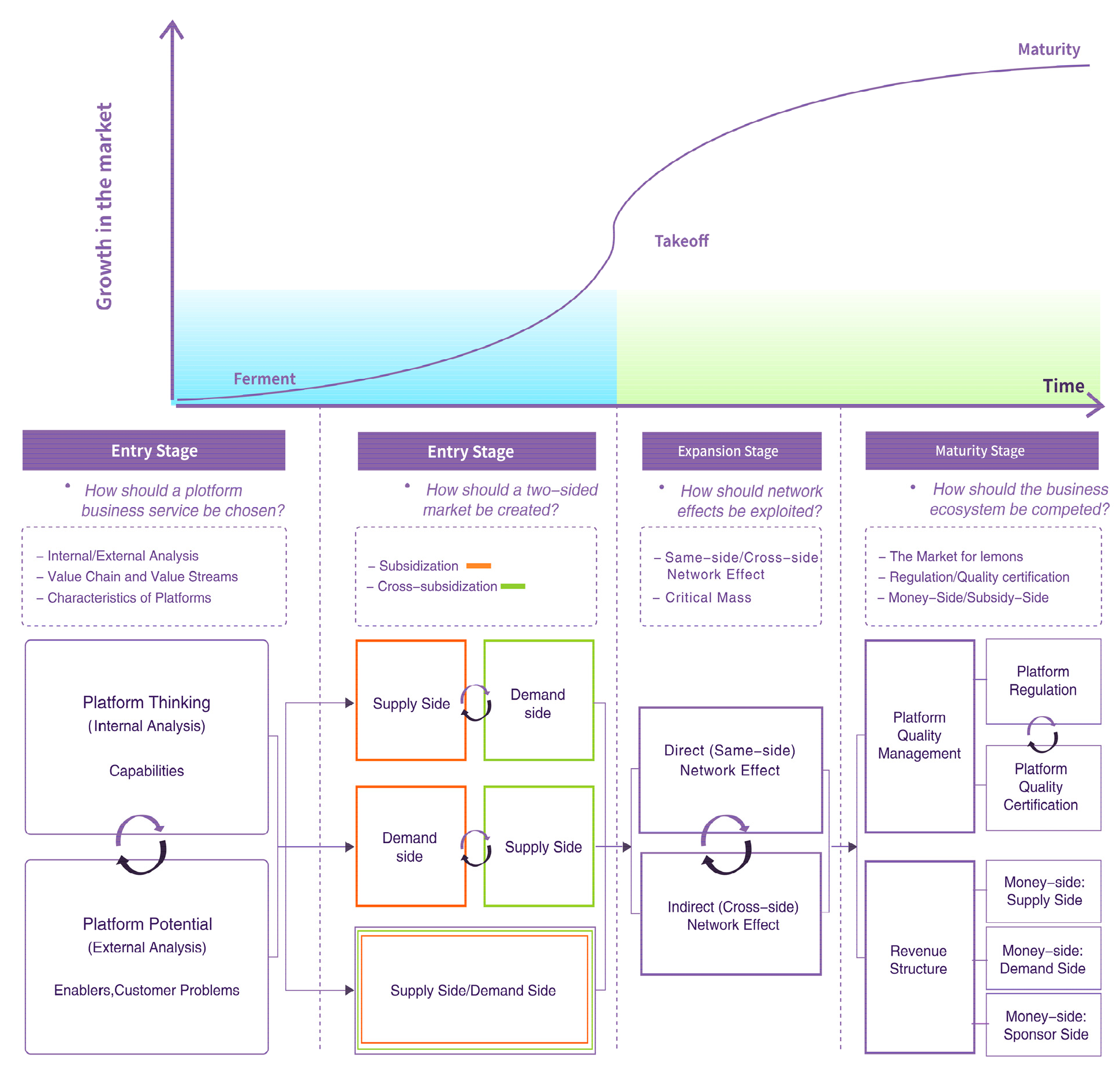
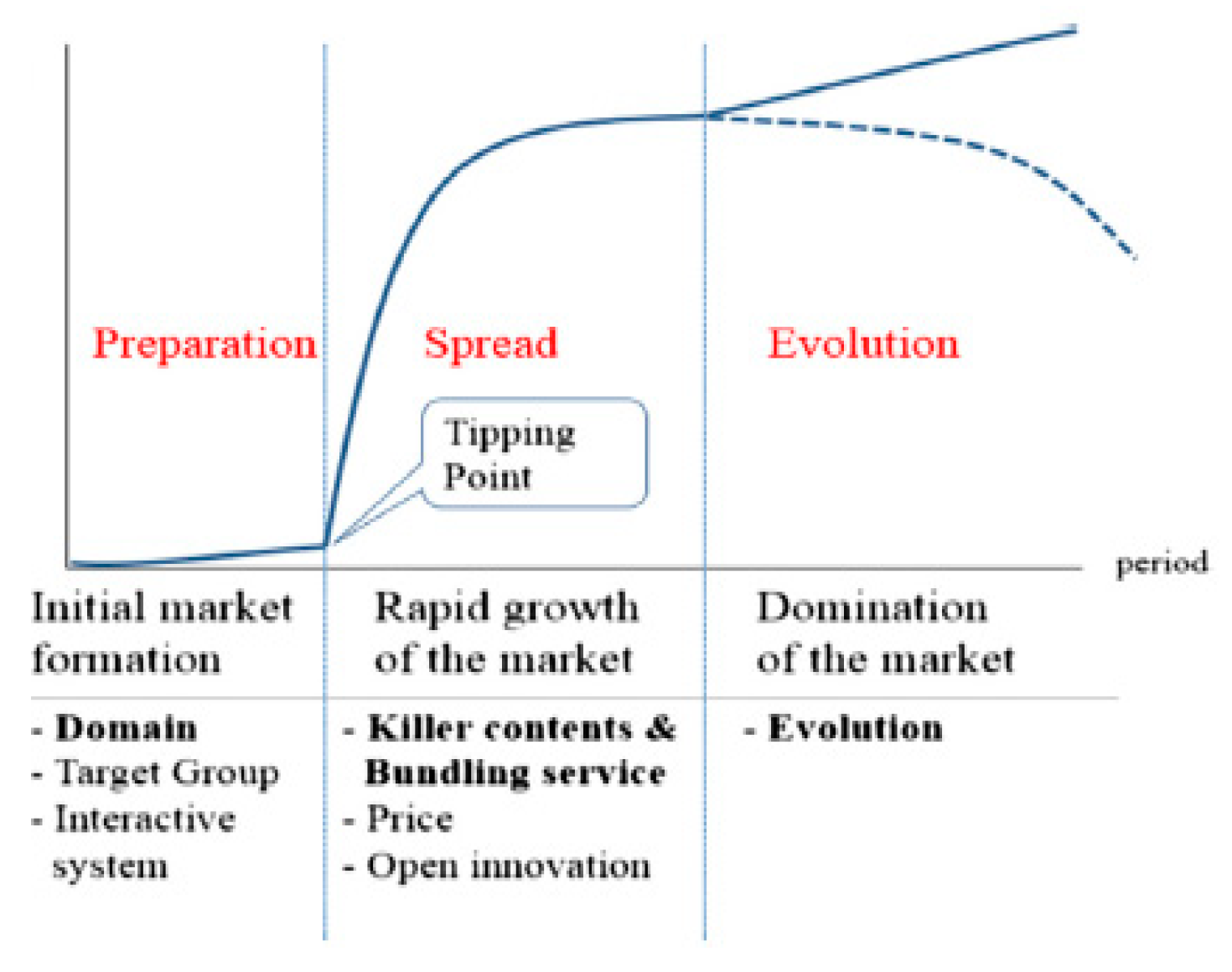
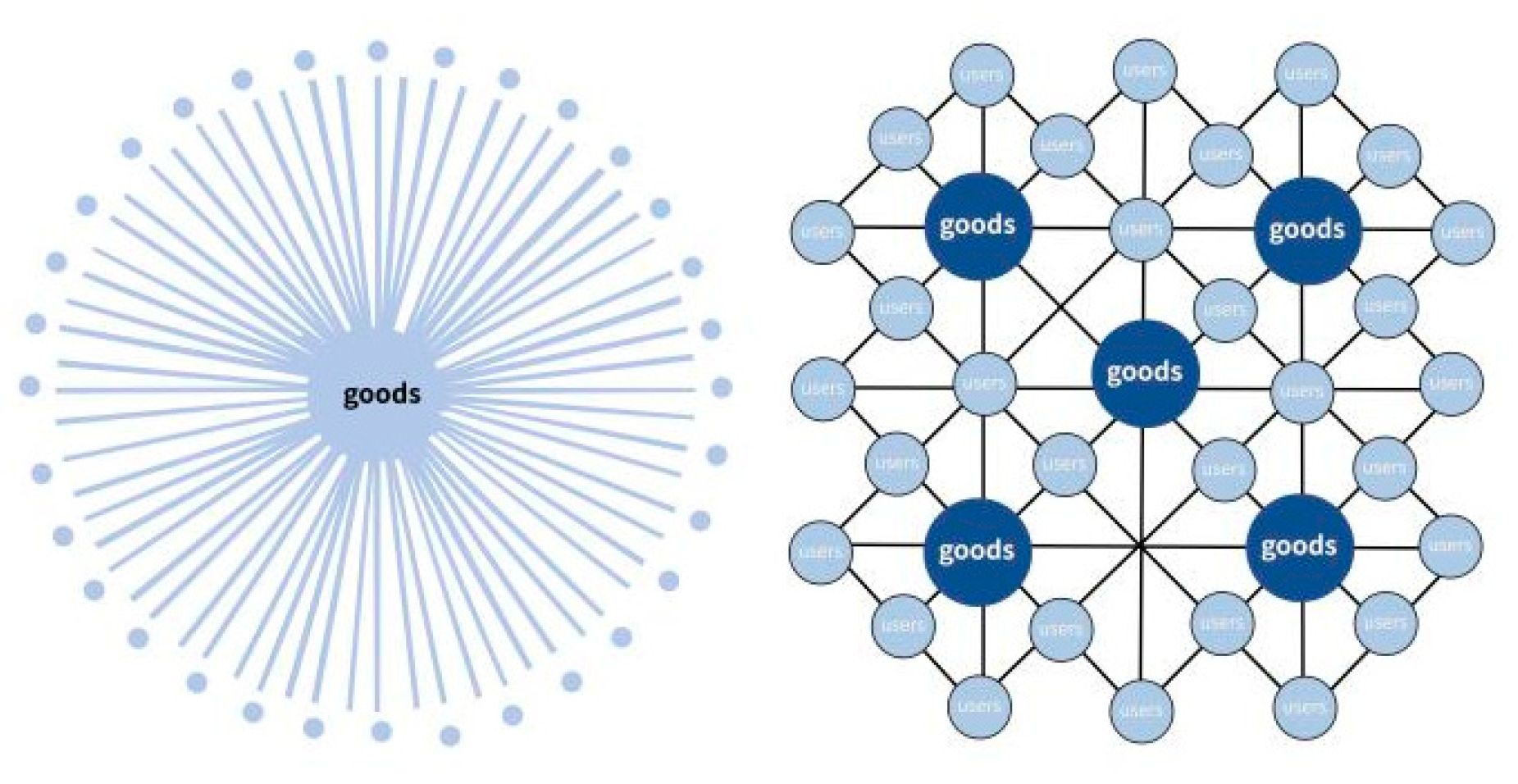
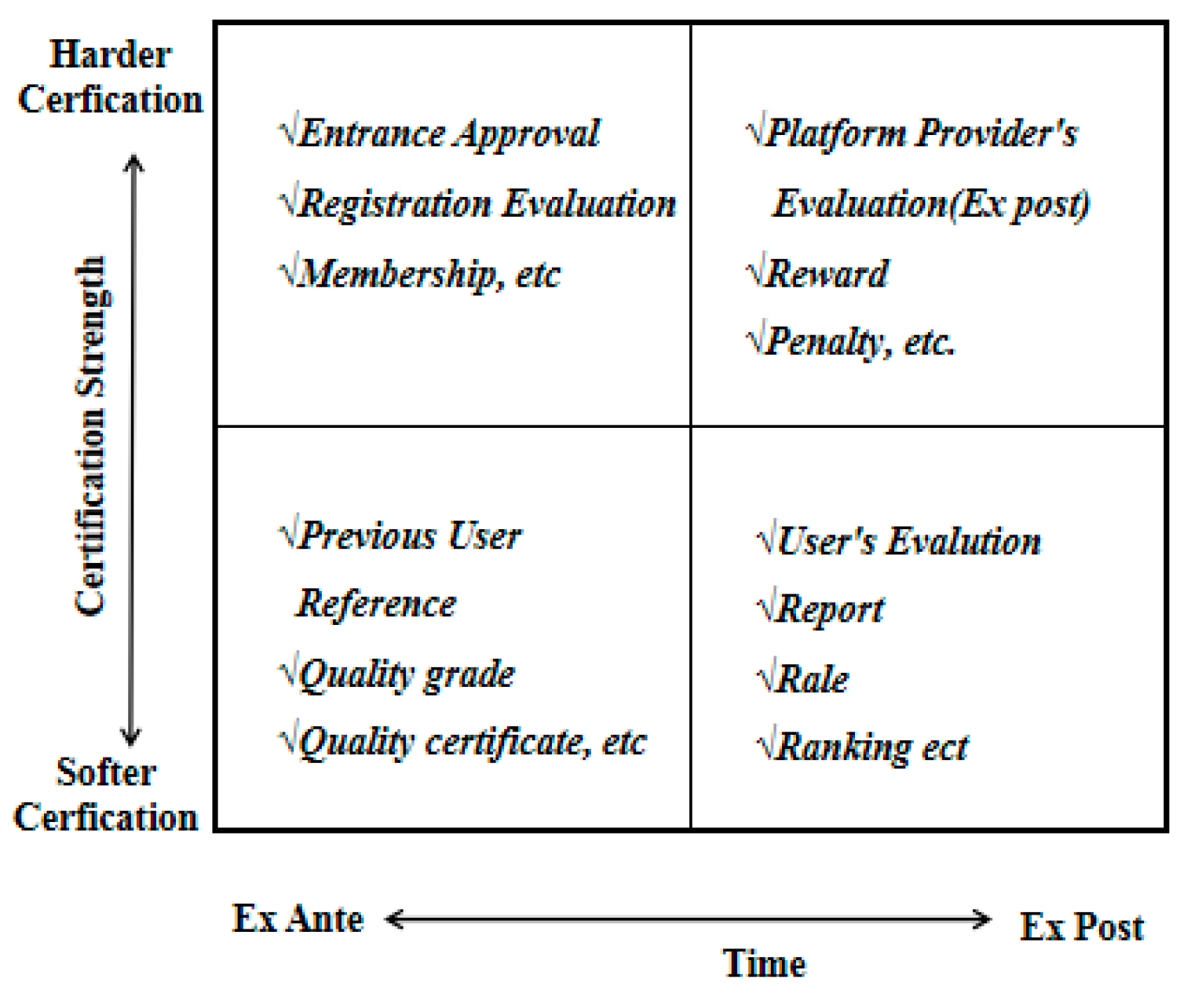
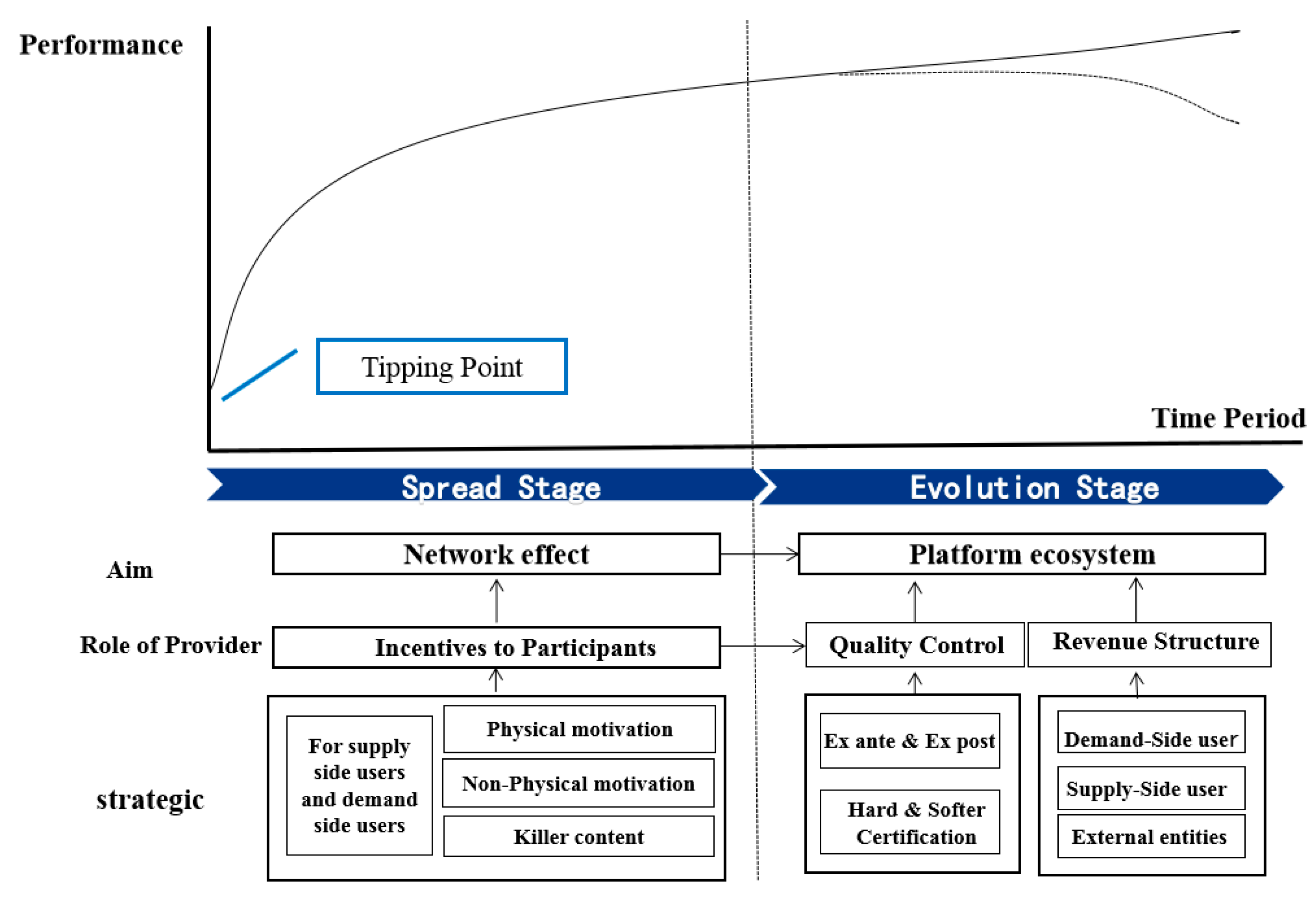
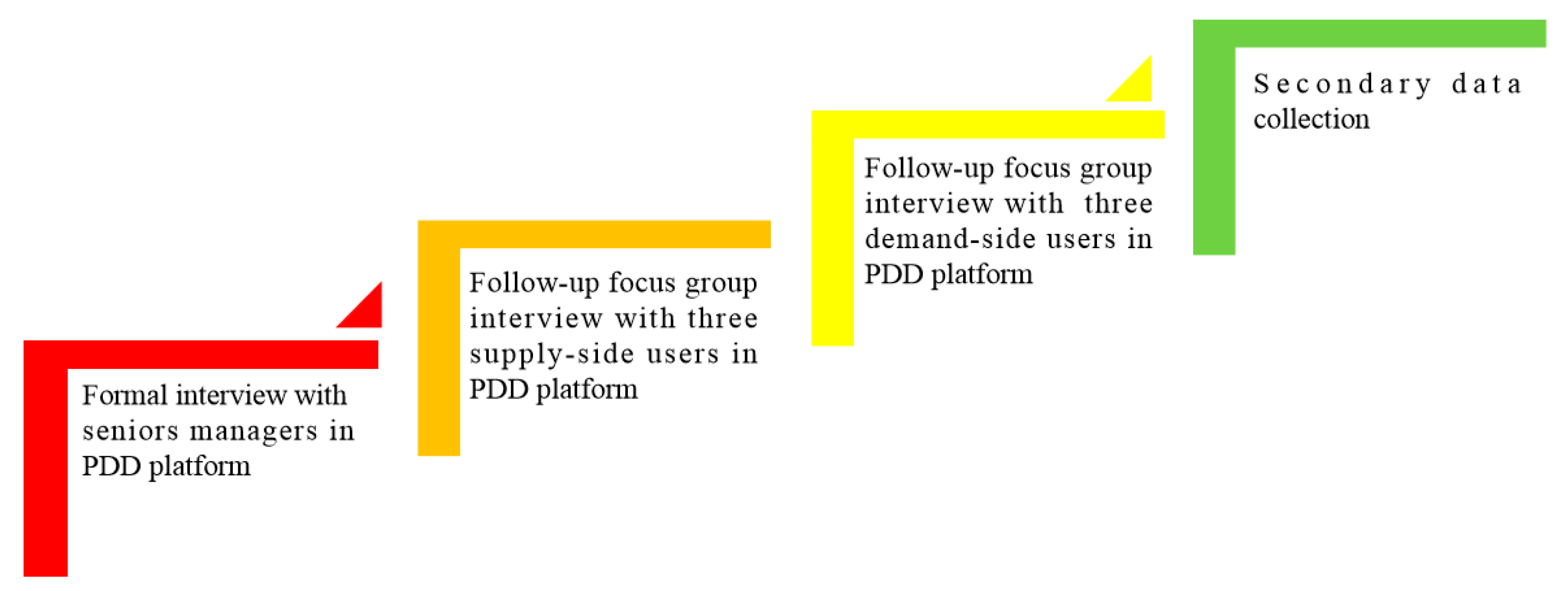
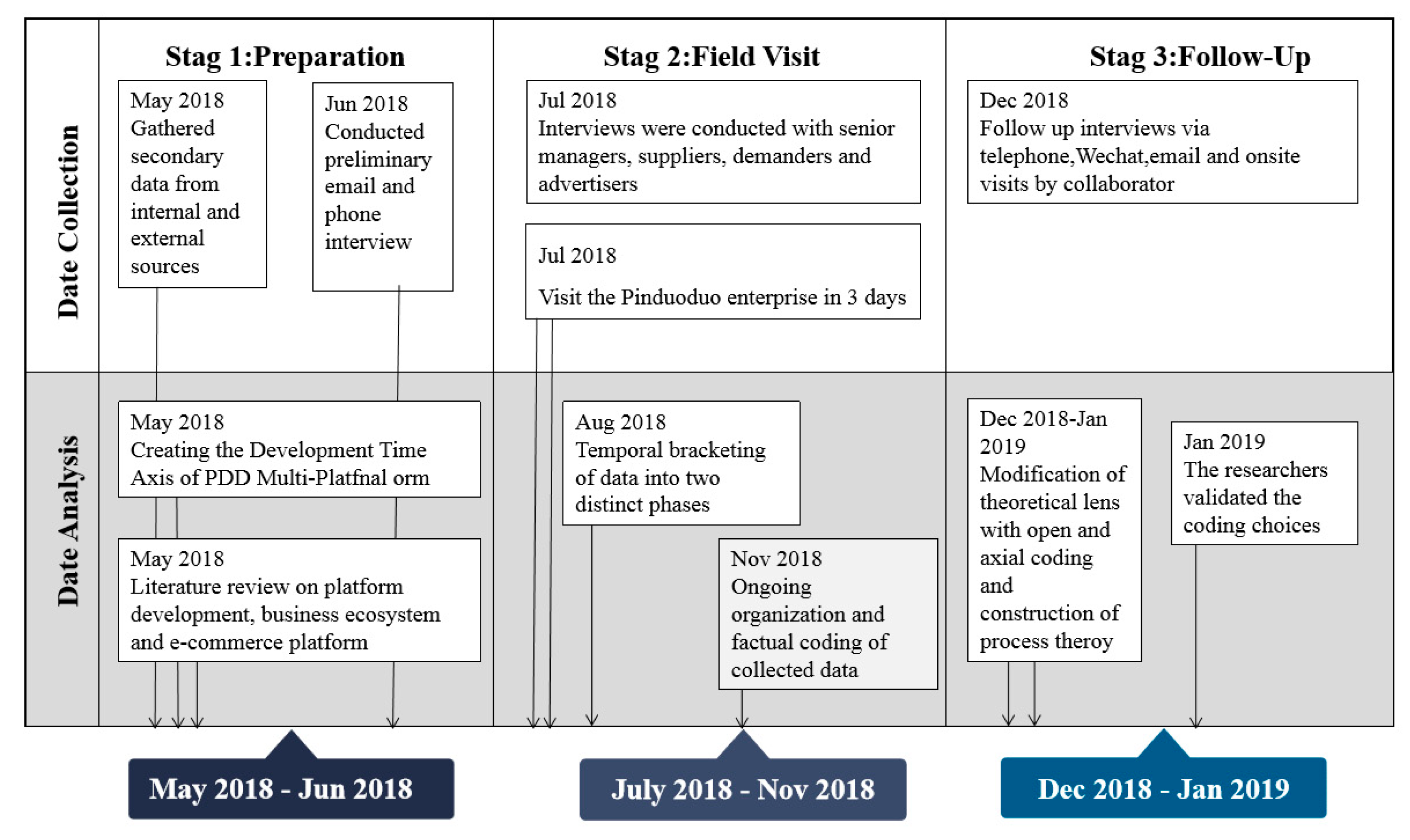

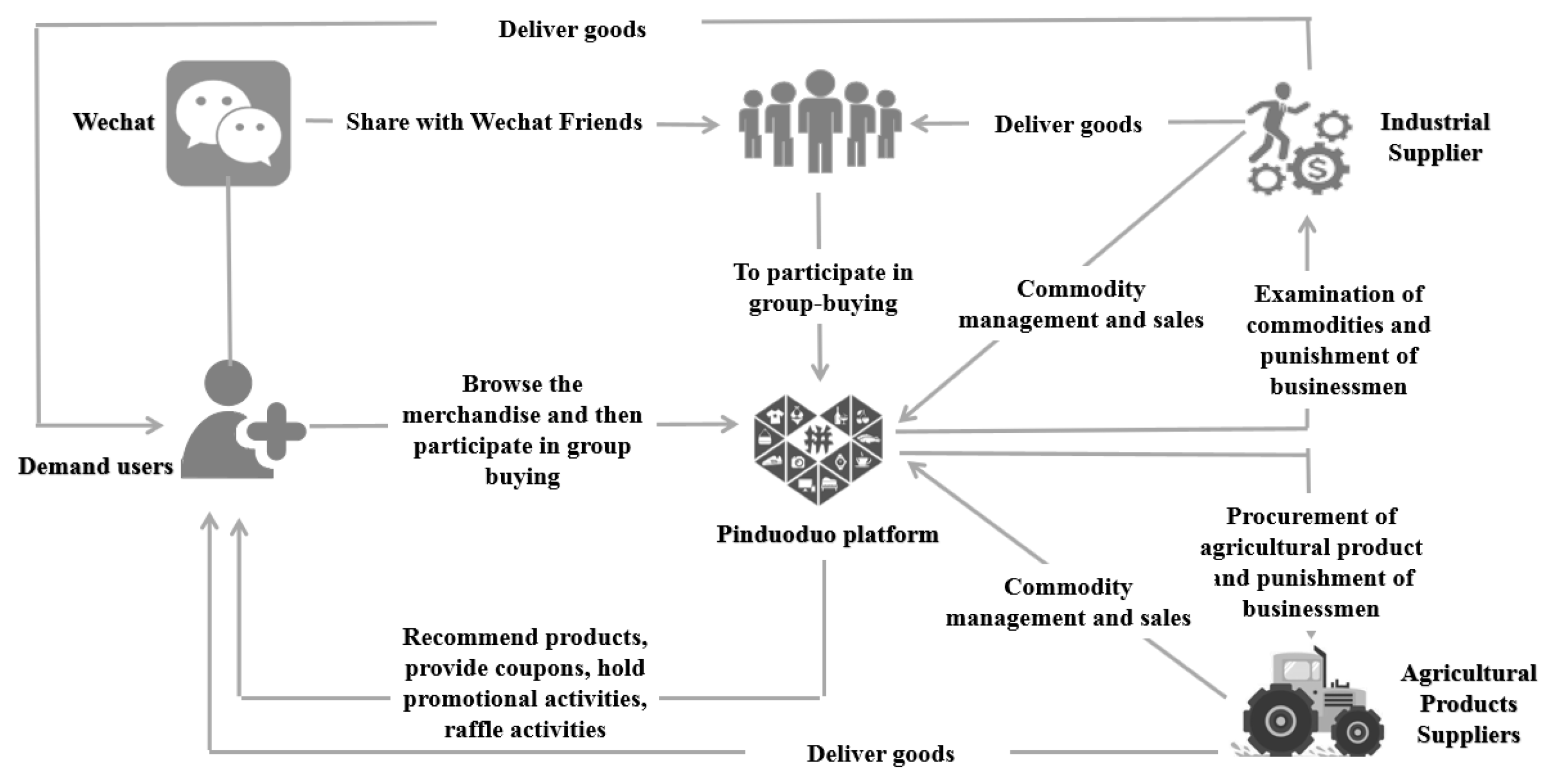
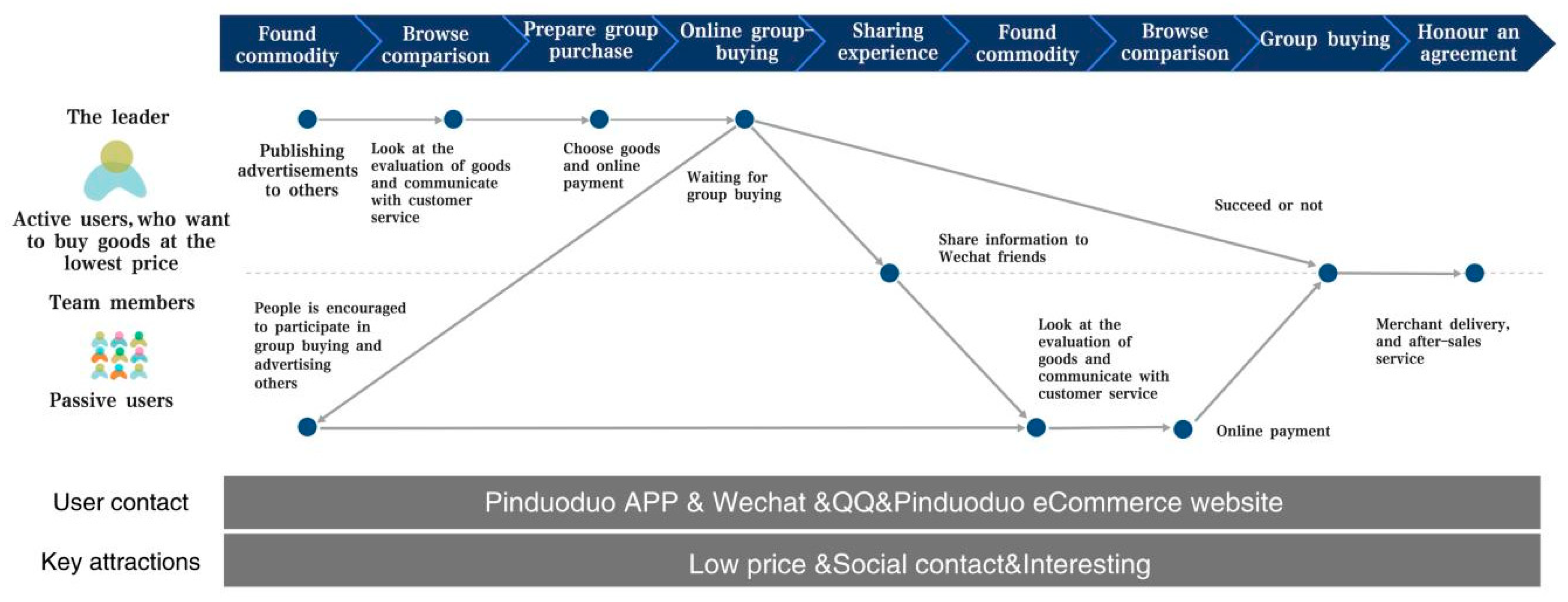
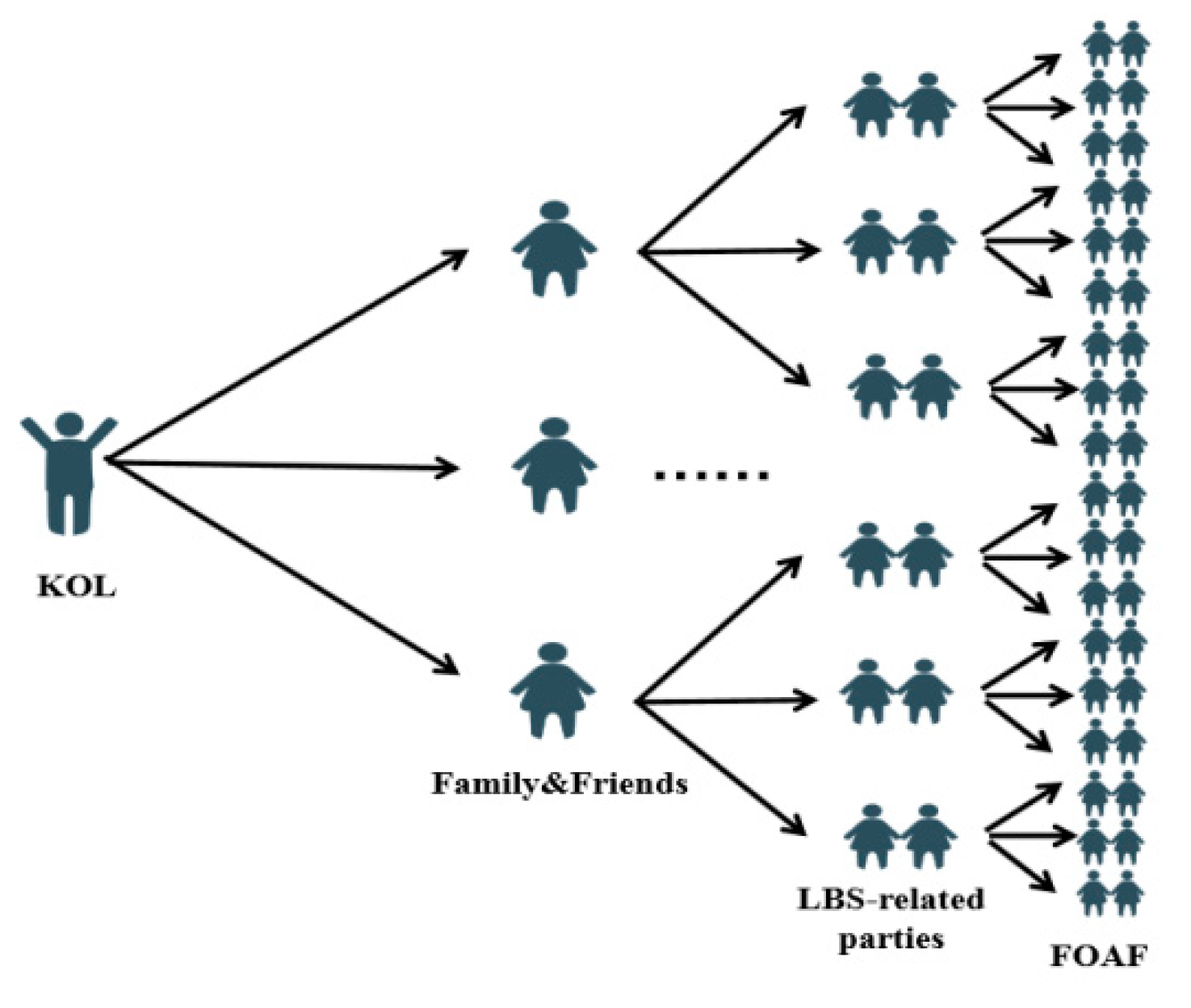
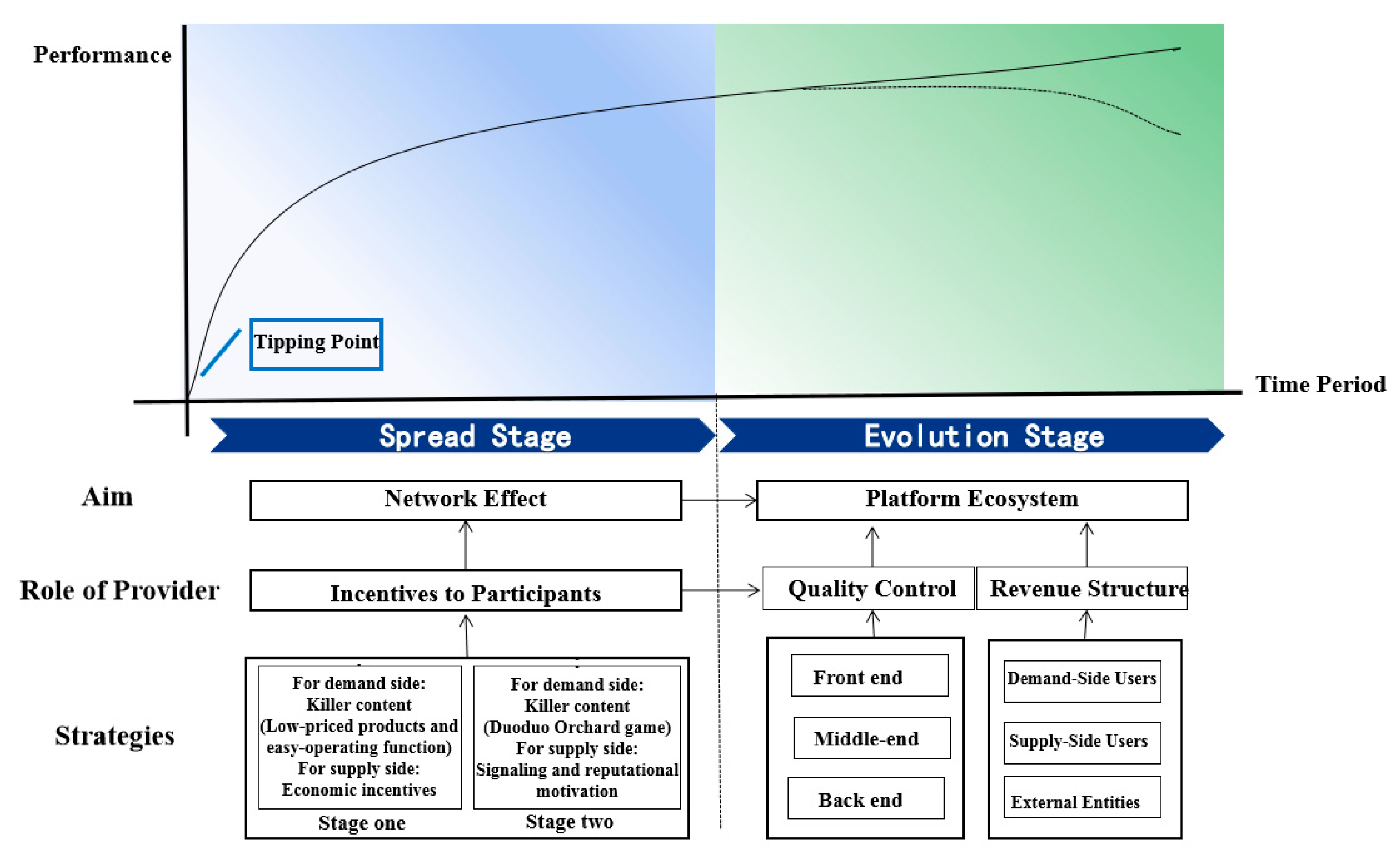
| Types of Motivations | Examples of Motivation | Relationship to Network Effects |
|---|---|---|
| Intrinsic | Self-interests and self-satisfaction; Own-use user innovation | Not related to networks effects |
| Reciprocating | Response to peers; Learning from interaction | Not related to networks effects |
| Signaling and Reputational | Public display and peer adaption of work activity | Related to network effect |
| Revenue-Structure | Money-Side | Subsidy-Side |
|---|---|---|
| Supply-type | Supply-side | Demand-side |
| Demand-type | Demand-side | Supply-side |
| Sponsor-type | External entities (sponsor) | Demand- and Supply-side |
| Exploratory Case Study | Descriptive Case Study | Explanatory Case Study | |
|---|---|---|---|
| Single case study | Exploratory Single Case Study | Descriptive Single Case Study | Explanatory Single Case Study |
| Multiple case studies | Exploratory Multiple Case Study | Descriptive Multiple Case Study | Explanatory Multiple Case Study |
| Focus of Platform Provider (1) Low Price + Social Contact | Focus of Platform Provider (2) Gamification + Channel Branding | |
|---|---|---|
| Demand-side strategies | • Killer content: Provide low-priced products and easy-operating functions for the people at the bottom of the pyramid | • Killer content: Duoduo Orchard game |
| Supply-side strategic | • Economic incentive | • Signaling and reputations incentive |
| Motivation Strength | High | High |
© 2019 by the authors. Licensee MDPI, Basel, Switzerland. This article is an open access article distributed under the terms and conditions of the Creative Commons Attribution (CC BY) license (http://creativecommons.org/licenses/by/4.0/).
Share and Cite
Zhao, W.; Wang, A.; Chen, Y. How to Maintain the Sustainable Development of a Business Platform: A Case Study of Pinduoduo Social Commerce Platform in China. Sustainability 2019, 11, 6337. https://doi.org/10.3390/su11226337
Zhao W, Wang A, Chen Y. How to Maintain the Sustainable Development of a Business Platform: A Case Study of Pinduoduo Social Commerce Platform in China. Sustainability. 2019; 11(22):6337. https://doi.org/10.3390/su11226337
Chicago/Turabian StyleZhao, Wu, AnQi Wang, and Yun Chen. 2019. "How to Maintain the Sustainable Development of a Business Platform: A Case Study of Pinduoduo Social Commerce Platform in China" Sustainability 11, no. 22: 6337. https://doi.org/10.3390/su11226337
APA StyleZhao, W., Wang, A., & Chen, Y. (2019). How to Maintain the Sustainable Development of a Business Platform: A Case Study of Pinduoduo Social Commerce Platform in China. Sustainability, 11(22), 6337. https://doi.org/10.3390/su11226337





